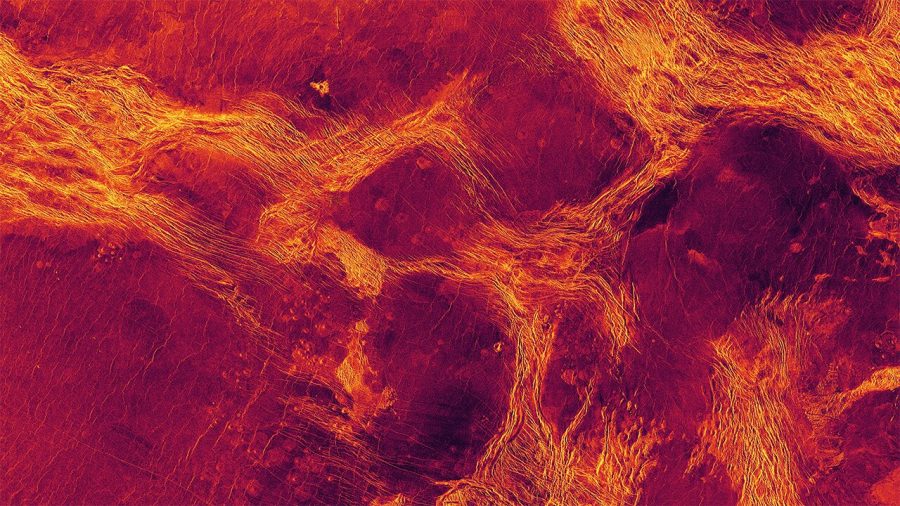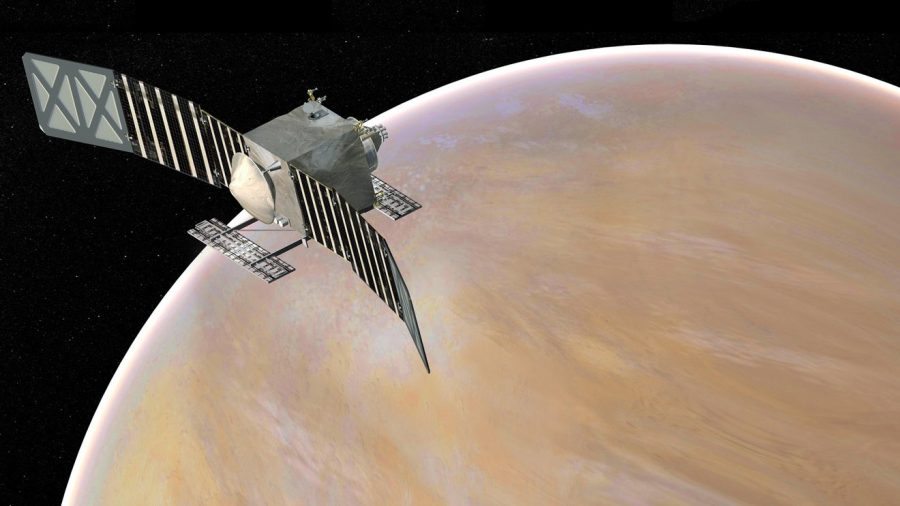A new analysis of old data suggests that some of our sister planet’s unique surface formations are due to a “squishy” crust and an active interior.
For a long time, scientists thought Venus had an immobile lithosphere like Mercury, the Moon, or Mars. After all, we knew it didn’t have moving tectonic plates, like Earth does, because there is no evidence of continent-scale subductions. But a recent study in the June 29th Proceedings of the National Academy of Sciences suggests that the ground truth might be somewhere in between.

NC State University, based on original NASA/JPL imagery
A team of planetary scientists led by Paul Byrne (North Carolina State University) looked at radar imagery taken by NASA’s Magellan probe. They focused on lowland regions with an interesting topography: seemingly undeformed blocks surrounded by ridges and grooves that indicate extensive deformation. The team built a computer model, which showed that these “blocks” appear to be moving against one another like pack ice on a frozen lake, and that motion is what creates the ridges and grooves.
“We argue that this pattern is best explained as indicating that the upper solid layer of Venus is fragmented and has moved, with some of that motion being geologically recent,” says Byrne.
The issue of whether or not Venus is geologically active revolves around its young population of impact craters. Since there do not appear to be any gigantic impact basins left over from the late-heavy bombardment period, it has been suggested that Venus was recently (500 million years ago) resurfaced. And since there seems to be little evidence of the kind of geologic movement that occurs on Earth, it was assumed that Venus’s crust is solid. But this study suggests that activity on our planet’s evil twin may just take on a slightly different character.
There are similar pack ice formations on continental interiors on our planet: the Sichuan Basin in southeastern China, the Amadeus Basin in central Australia, and the Black Sea and South Caspian basins, to name just a few. These are typically low-lying areas boxed in by small mountain ranges.
“Earth’s continents and the Venus lowlands have different compositions,” Bryne says. “And what's causing the jostling is a bit different. But what we see in these blocks or campi of Venus, is quite similar to the style of deformation you see within Earth’s continents.”
The team used the same terminology to describe this crustal behavior as in an 1875 scientific paper, in which a researcher named Dr. Seuss described the jostling of continental blocks as being like pack ice. While this is a known feature in select areas on Earth, this study suggests that it may be a more global feature on Venus.
“The crustal blocks are defined by smooth planes and highly deformed boundaries,” says team member Richard Ghail (University of London). “This indicates they are mobile, perhaps being driven by mantle flow.” If so, this would add to evidence that Venus has an active geology.
While scientists have long suspected that the crusts of rocky planets would have a whole spectrum of mobility, Venus’s “squishy” topology may be the first entry in a new category, a crust type beyond solid lithospheres and mobile plates. Indeed, the “pack ice” model might even represent geology on early Earth billions of years ago, before the continents had fully formed. Then, the interior was hotter, and the crust might have been thinner and squishier, like present day Venus. Studying our neighbor’s geology could give us a better picture of the history of our own planet.
Colin Wilson (Oxford University, UK), who was not involved in the study, says that while the team’s analysis seems robust, new and better data is needed to check the pack ice scenario. Fortunately, two upcoming missions to Venus will improve our understanding of Venus’s geology: NASA’s VERITAS and ESA’s EnVision.

NASA / GSFC
“To reconstruct the chronology of what happened on Venus, we need higher resolution topography than we got from Magellan, and also a gravity map,” Wilson says. “Both of the orbiters could do this; giving us data on apparent crustal thickness, active mantle upwelling, and if there’s interior convection in the mantle.”
But the most exciting possibility would be to measure activity on the surface today. This is extremely difficult because, except for volcanic eruptions and earthquakes, tectonic plates on Earth typically move on a scale of centimeters per year (such as the way California is slowly falling into the Pacific Ocean). Barring a lucky eruption on Venus, equipment needs to be sensitive enough to detect the sort of mundane deformations that are happening all the time, everywhere. Both mission science teams are looking into whether they'd be able to detect such centimeter-scale deformations using their radar instruments.
“When we get the data back from VERITAS and EnVision in 10 years time, it will change our understanding of Venus overnight,” Ghail said. “At the moment we have a good notion of what's going on, but we don't have all the evidence yet.”
 0
0








Comments
You must be logged in to post a comment.